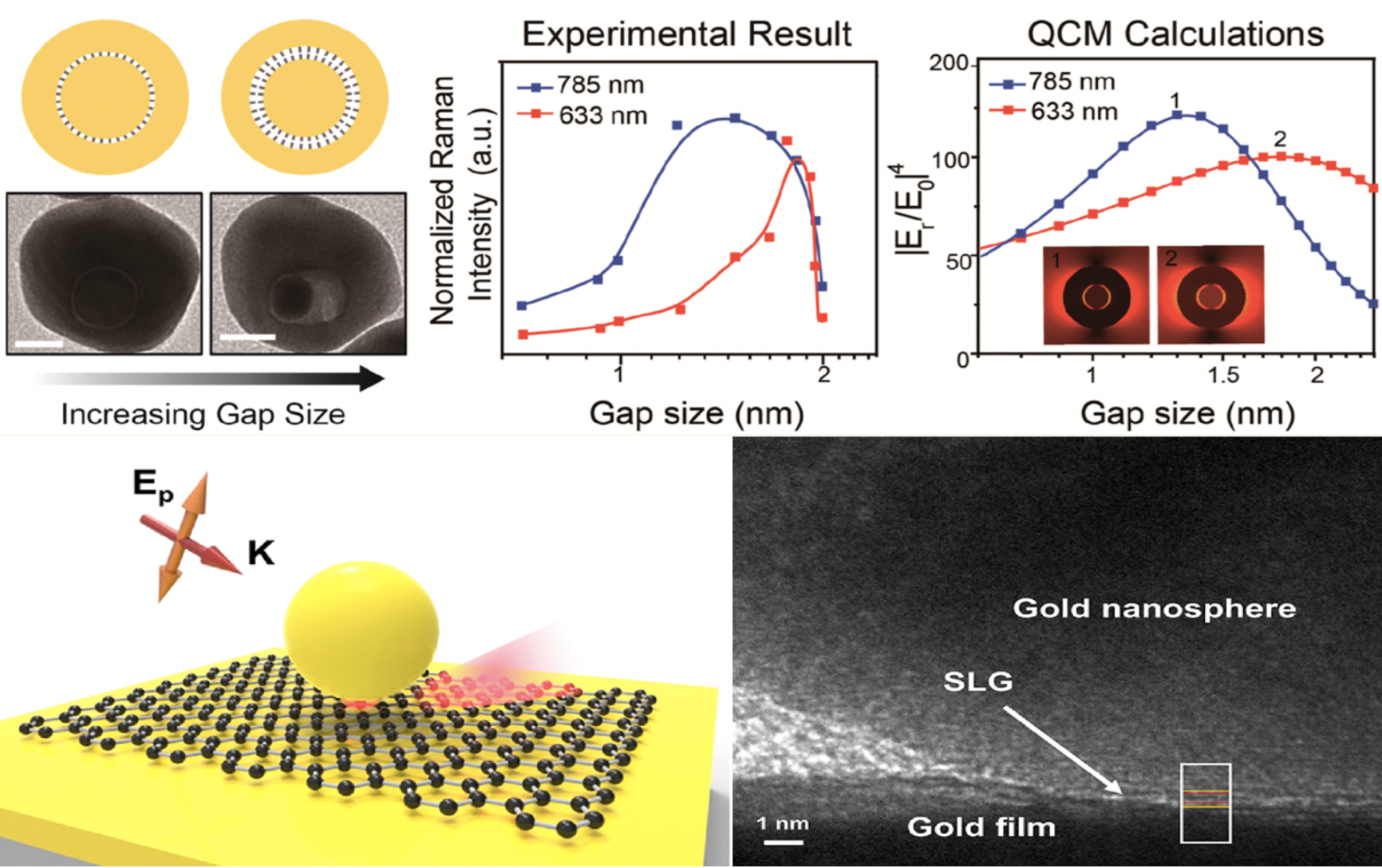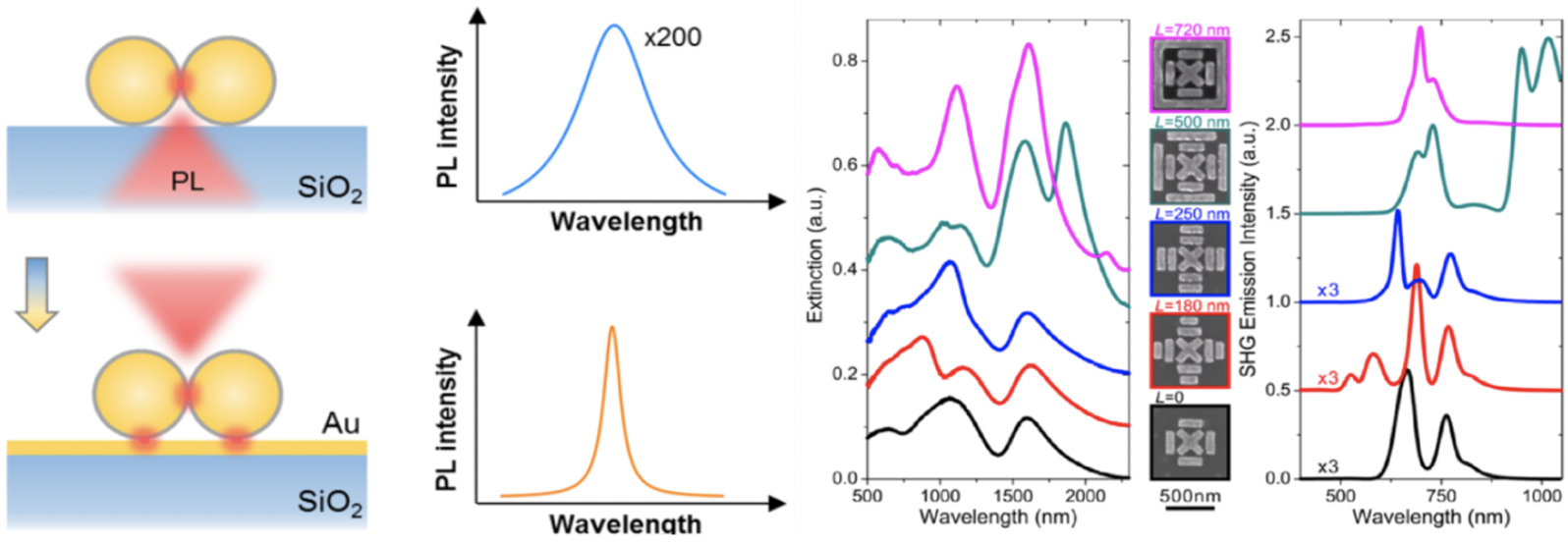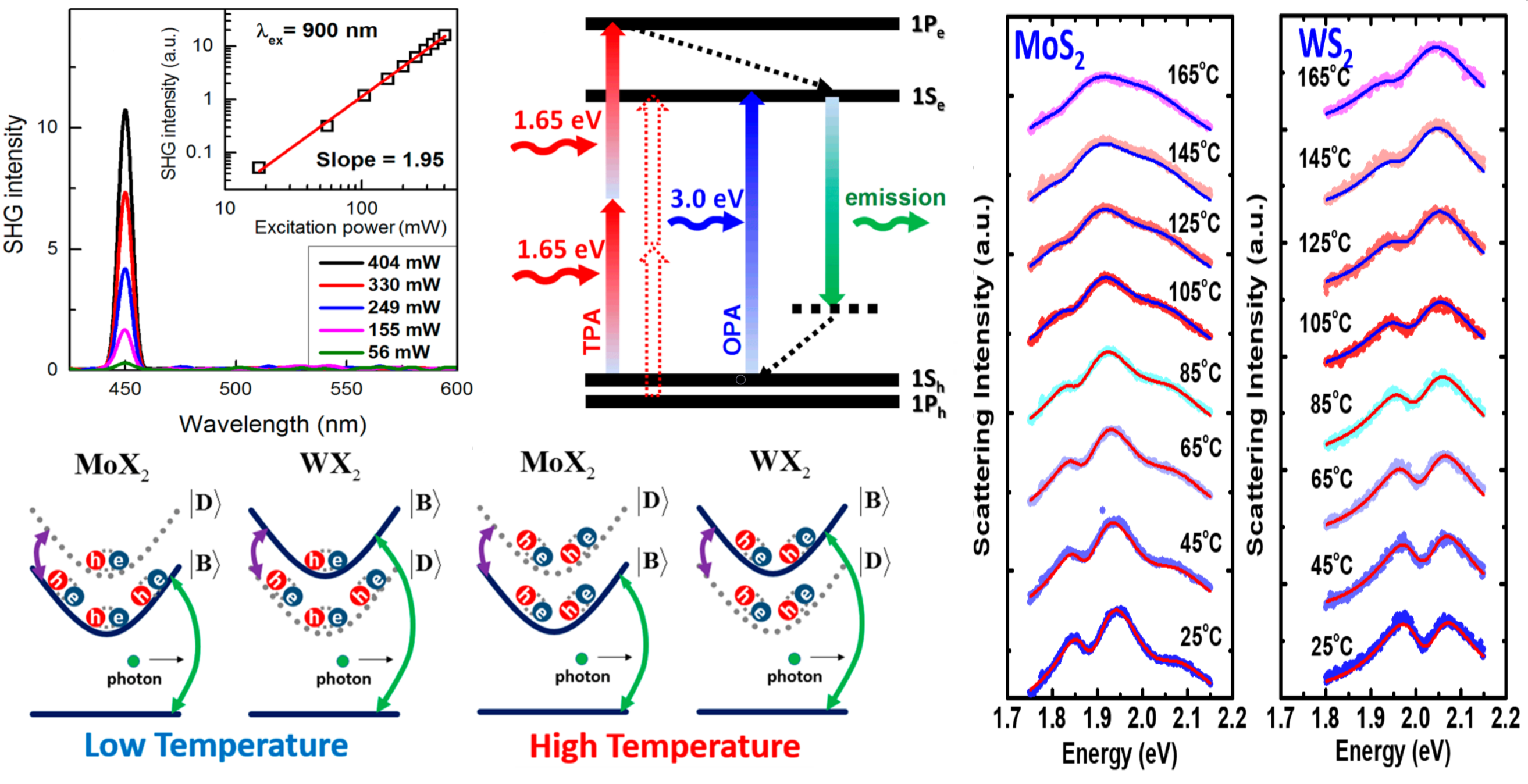Introduction
We are devoted to the research on nano-photonics and optoelectronics based on low-dimensional quantum materials and structures by exploring cavity-enhanced light-matter interaction at the nanoscale. Recently, we are particularly interested in the extreme and quantum plasmonics research that studies the far- and near-field optical properties of metallic nanocavities possessing characteristic sizes less than one nanometer. By combining sophisticated experimental measurements and theoretical analysis at the single-particle level, we have shed light on several important quantum mechanical size effects in such extreme nanocavities, including spatial nonlocality, electron tunneling, and quantum charge transport. We also devote our attention to the elementary excitations in low-dimensional materials systems, including exciton, plasmon and phonon polaritons and their rich electromagnetic coupling phenomena. These fundamental studies on the physics of solids have important implications for relevant applications in improved light harvesting, advanced biosensing and bioimaging.
Quantum plasmonics and nonlinear nanophotonics
When metallic nanostructures have sub-nanometer feature sizes, their far-field and near-field plasmonic properties cannot be accurately described by classical electromagnetic theories because of the emergence of several important quantum mechanical size effects such as spatial nonlocality, quantum tunneling and electron transport. Although recent experimental and theoretical studies have revealed pronounced quantum signatures in sub-nanometer sized metallic structures, the plasmonics community still calls for comprehensive understanding of their manifestation in strongly coupled structures and the respective working range of each effect. In the context of the aforesaid research background, our group has carried out the following representative studies over the past few years:
(1) applied surface-enhanced Raman spectroscopy of graphene to reveal the limiting effect of spatial nonlocality in plasmonic near-field enhancements in rough metal films (Nanoscale 6 (3), 1311-1317, 2014) and metallic particle-on-film nanocavities (ACS Nano 13 (7), 7644-7654, 2019);
(2) used electron energy-loss spectroscopy to study the effects of spatial nonlocality and electron tunneling in the bonding and anti-bonding dipolar resonances of metallic nanosphere dimers (Advanced Quantum Technologies 1, 1800016, 2018);
(3) employed surface-enhanced Raman scattering (ACS Nano 12 (7), 6492-6503, 2018) and two-photon photoluminescence spectroscopy (Nanophotonics 10 (9), 2467-2479, 2021) to reveal the quantum charge transport phenomena in three-dimensional plasmonic molecular junctions.
(4) Discovered the long-hidden phenomenon of light-induced electromagnetic asymmetry in symmetry-broken plasmonic nanocavities and unravelled its fundamental role in enhancing the frequency up-conversion efficiency of coherent light at the nanoscale, such as second-harmonic generation (Nature Communications 12, 4326, 2021).


Exciton polaritons in low-dimensional semiconductors
Low-dimensional transition metal dichalcogenides (TMDCs) have rich parity-related one- and two-photon excitonic transitions and spin-orbit coupling induced bright and dark excitons. However, probing and manipulating parity- or spin-forbidden dark excitons requires the use of either nonlinear optical spectroscopy or the inhomogeneous fields and the associated Purcell effects as well as extreme approaches. In this context, we have:
(1) observed the C-exciton resonance enhanced second-harmonic generation in chemically prepared MoS2 nanosheets and demonstrated how to combine one- and two-photon photoluminescence excitation spectroscopy to determine the energy splitting of the parity-allowed 1Se and parity-forbidden 1Pe excitonic states in MoS2 nanodots (ACS Photonics 3 (12), 2434-2444, 2016);
(2) developed an elegant tight-binding model to understand the measured layer-dependent exciton resonance energies of WS2 (Nanoscale Horizons 4 (4), 969-974, 2019), showing good agreement with the density functional theory calculation results; we have also shown that the temperature dependence of the A-exciton emission energy in monolayer WS2 can be well described with the Varshni formula and its temperature-dependent emission intensity can be attributed to the thermal-induced redistribution of bright and dark exciton populations at elevated temperatures;
(3) shown in the strong coupling regime how to utilize plasmon-exciton strong coupling spectroscopy to determine the dark exciton energies of monolayer MoS2 and WS2 by examining their respective temperature-dependent bright-exciton coupling strength with the localized surface plasmons of a single metallic nanoparticle (ACS Photonics 6, 411-421, 2019);
(4) investigated in the weak coupling regime the Purcell effect-enhanced excitonic photoluminescence of monolayer MoS2 inserted in the gap of a gold nanoparticle–alumina–gold film structure. Under confocal illumination by a 532 nm CW laser, we observed a 7-fold emission intensity enhancement for the cavity-sandwiched MoS2 at an optimal alumina thickness of 5 nm, corresponding to a local emission enhancement of ∼350 by normalizing the actual illumination area to the cavity’s effective near-field enhancement area (Nanophotonics 9 (7), 2097-2015, 2019);
(5) demonstrated that the coupling of spin-forbidden dark excitons to an ultrathin metal nanoparticle-on-mirror nanocavity leads to plasmon-induced resonant emission with the intensity comparable to that of the spin-allowed bright excitons. A three-state quantum model combined with full-wave electrodynamic calculations reveals that the radiative decay rate of the dark excitons can be enhanced by nearly 6 orders of magnitude through the Purcell effect, therefore compensating its intrinsic nature of weak radiation (Nano Letters 22 (5), 1915-1921, 2022);
(6) developed a Pb-S bonding approach to synthesize water-resistant perovskite@silica nanodots, and demonstrated a two-photon-pumped whispering-gallery mode laser device made of these ultra-stable nanodots, retaining 80% of its initial emission quantum yield when immersed in water for 13 h (Nature Communications 11, 1192, 2020).

Plasmonics and metasurfaces for sensing and imaging
Plasmonics nanostructures and dielectric metasurfaces have found diverse applications in the areas of chirality-based biochemical sensing (Advanced Materials 32 (41), 1907151, 2020), high-resolution optical imaging with non-diffracting, self-accelerating Bessel bemas (Laser & Photonics Reviews 15 (5), 2000487, 2021) and Airy beams (ACS Nano 15 (1), 1030-1308, 2021).
In 2014, we and co-workers demonstrated the design and preparation of a hierarchical porous plasmonic metamaterial, which gives rise to highly reproducible ultrasensitive surface‐enhanced Raman scattering (SERS, (Advanced Materials 27 (6), 1090-1096, 2015). This work represents one of the few pioneering attempts in applying the hierarchical metamaterial concept to address the long-standing issues of SERS – reproducibility and sensitivity, and was selected as an ESISM Highly Cited Paper (Top 1% in the academic field of Materials Science for its publication year).
Our research results on SERS-based biochemical sensing (Journal of Physical Chemistry Letters 10 (16), 4692-4698, 2019; Nanoscale 6 (15), 9063-9070, 2014; Journal of Applied Physics 114 (12), 124305, 2013), plasmonic nanorulers ( ACS Nano 8 (9), 9188-9198, 2014) and phase-changing tunable SERS (Advanced Optical Materials 10 (8), 2102615, 2022) have been
well recognized by the plasmonics SERS community, for which we have been invited to contribute a chapter to the book entitled "Recent Developments in Plasmon-Supported Raman Spectroscopy: 45 Years of Enhanced Raman Signals", edited by K. Kneipp, Y. Ozaki and Z.-Q. Tian, World Scientific Publishing, 2018.

Photonic nanomaterials and meta-structures for energy conversion and saving
In addition to biochemical sensing applications, we have made a great deal of efforts in applying photonic nanomaterials and meta-structures to improve the energy conversion and saving efficiency.
With regard to energy conversion, we have systematically examined the roles of plasmonic nanostructures in enhancing the light harvesting and energy conversion efficiencies of various types of solar cells, including the strong competition between plasmonic absorption enhancement and surface energy quenching in a dye-sensitized solar cell (Nano Energy 26, 297-304, 2016), the realization of plasmon-induced broadband light absorption and scattering enhancement in a perovskite thin-film solar cell (Nano Energy 41, 656-664, 2017), quantitative contribution from plasmon-enhanced electric near-field, antenna-amplified light scattering and surface energy transfer to the overall performance of a plasmonic organic solar cell (Small 14 (30), 1800870, 2018), the observation of plasmon-induced defect passivation at grain boundaries in a perovskite solar cell (Light: Science & Applications 10, 219, 2021), and the recent discovery of plasmonic local heating induced strain relaxation in perovskite solar cells for enhanced power conversion efficiency and operational stability (Advanced Energy Materials 12 (19), 2200186, 2022).
With regard to energy saving, my group and research collaborators from local institution, mainland China and US have recently invented an eco-friendly, low-cost smart coating to keep buildings cooler while consuming zero electricity (Advanced Materials 32 (42), 1906751, 2020). This invention is grounded on a totally new cooling mechanism - smart sub-ambient radiative cooling, which can enhance daytime cooling and minimize nighttime heat loss mechanism. It was selected as “Editor’s Choice” of Science 370 (6522), 1287-1288, 2020, reported in Advanced Science News and public media, and receieved a Gold Medal of The International Exhibition of Inventions of Geneva (2022) We have further shown that introducing fluorescent materials into polymeric coatings can covert the absorbed sunlight to fluorescent emissions and hence increase the effective solar reflectance and cooling performance. Using phosphors with smaller Stokes shifts and TiO2 nanoparticle fillers of appropriate sizes can significantly enhance the effective solar reflectance matching the emission wavelength of the former with the Mie scattering resonance wavelength of the latter, leading to fluorescence-mediated radiative cooling (Journal of Materials Chemistry A 10 (37), 19635-19640, 2022; selected into the themed issue of Emerging Investigators). This new approach provides an effective strategy for making radiative cooling coatings compatible with commercially available inexpensive engineering materials and potentially for realizing colored coatings.
